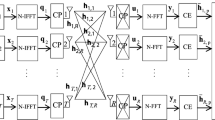Abstract
Time domain synchronization orthogonal frequency division multiplexing technique (TDS-OFDM) can offer better efficiency in spectrum and energy use than standard cyclic prefix and zero padding schemes by replacing the guard interval with a pseudorandom noise sequence. In this paper, a type of frequency domain pseudorandom noise training sequence is proposed for underwater acoustic channel as a TDS-OFDM training sequence and used to update the Doppler scaling factor estimation obtained by using a preamble signal after the initial system is synchronized. A significant improvement can also be achieved in bit error rate performance by the use of the compressed sensing theory to estimate underwater acoustic channel impulse response based on the proposed TDS-OFDM training sequence. Furthermore, the guard interval amplitude in TDS-OFDM can be reduced to improve the resultant energy efficiency and signal-to-interfered-signal ratio. The proposed techniques are carefully developed based on intuitive analysis and combined in a receiver design. Such receiver is evaluated in a measured underwater acoustic channel and a simulated channel. Both technical analysis and experiment results show significant and consistent performance improvements in spectral and energy use.









Similar content being viewed by others
References
Dai, L., Wang, J., Wang, Z., Tsiaflakis, P., & Moonen, M. (2013). Spectrum- and energy-efficient OFDM based on simultaneous multi-channel reconstruction. IEEE Transactions on Signal Processing, 61, 1–13.
Esmaiel, H., & Jiang, D. (2014). Zero-pseudorandom noise training OFDM. Electronics Letters, 50, 650–652.
Martin, R. K., Vanbleu, K., Ming, D., Ysebaert, G., Milosevic, M., Evans, B. L., et al. (2005). Unification and evaluation of equalization structures and design algorithms for discrete multitone modulation systems. IEEE Transactions on Signal Processing, 53, 3880–3894.
van Waterschoot, T., Le Nir, V., Duplicy, J., & Moonen, M. (2010). Analytical expressions for the power spectral density of CP-OFDM and ZP-OFDM signals. IEEE Signal Processing Letters, 17, 371–374.
Baosheng, L., Shengli, Z., Stojanovic, M., Freitag, L., & Willett, P. (2008). Multicarrier communication over underwater acoustic channels with nonuniform doppler shifts. IEEE Journal of Oceanic Engineering, 33, 198–209.
Mason, S. F., Berger, C. R., Shengli, Z., & Willett, P. (2008). Detection, synchronization, and doppler scale estimation with multicarrier waveforms in underwater acoustic communication. IEEE Journal on Selected Areas in Communications, 26, 1638–1649.
Jianming, W., Chen, Y., Xiaoyang, Z., & Hao, M. (2007). Robust timing and frequency synchronization scheme for DTMB system. IEEE Transactions on Consumer Electronics, 53, 1348–1352.
Liu, Z., & Yang, T. C. (2013). On overhead reduction in time-reversed OFDM underwater acoustic communications. IEEE Journal of Oceanic Engineering, 39, 1–13.
Zhiqiang, L., & Yang, T. C. (2012). On the design of cyclic prefix length for time-reversed OFDM. IEEE Transactions on Wireless Communications, 11, 3723–3733.
Duarte, M. F., & Eldar, Y. C. (2011). Structured compressed sensing: from theory to applications. IEEE Transactions on Signal Processing, 59, 4053–4085.
Donoho, D. L. (2006). Compressed sensing. IEEE Transactions on Information Theory, 52, 1289–1306.
Berger, C. R., Zhou, S., Preisig, J. C., & Willett, P. (2010). Sparse channel estimation for multicarrier underwater acoustic communication: From subspace methods to compressed sensing. IEEE Transactions on Signal Processing, 58, 1708–1721.
Yang, T. C. (2005). Correlation-based decision-feedback equalizer for underwater acoustic communications. IEEE Journal of Oceanic Engineering, 30, 865–880.
Linglong, D., Zhaocheng, W., & Sheng, C. (2011). A novel uplink multiple access scheme based on TDS-FDMA. IEEE Transactions on Wireless Communications, 10, 757–761.
Wicker, S. B. (1995). Error control systems for digital communication and storage. Prentice-Hall, Inc.
Jian, F., Jun, W., Jian, S., Chang-Yong, P., & Zhi-Xing, Y. (2008). A simplified equalization method for dual PN-sequence padding TDS-OFDM systems. IEEE Transactions on Broadcasting, 54, 825–830.
Yang, Z., Wang, X., Wang, Z., Wang, J., & Wang, J. (2010). Improved channel estimation for TDS-OFDM based on flexible frequency-binary padding. IEEE Transactions on Broadcasting, 56, 418–424.
Esmaiel, H., & Jiang, D. (2014). Time reversal time-domain synchronisation orthogonal frequency division multiplexing over multipath fading channels with significant tap delays. The Journal of Engineering, 1, 1–10.
Author information
Authors and Affiliations
Corresponding author
Rights and permissions
About this article
Cite this article
Esmaiel, H., Jiang, D. Spectrum and Energy Efficient OFDM Multicarrier Modulation for an Underwater Acoustic Channel. Wireless Pers Commun 96, 1577–1593 (2017). https://doi.org/10.1007/s11277-017-4257-5
Published:
Issue Date:
DOI: https://doi.org/10.1007/s11277-017-4257-5




